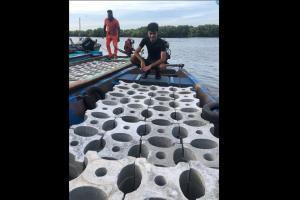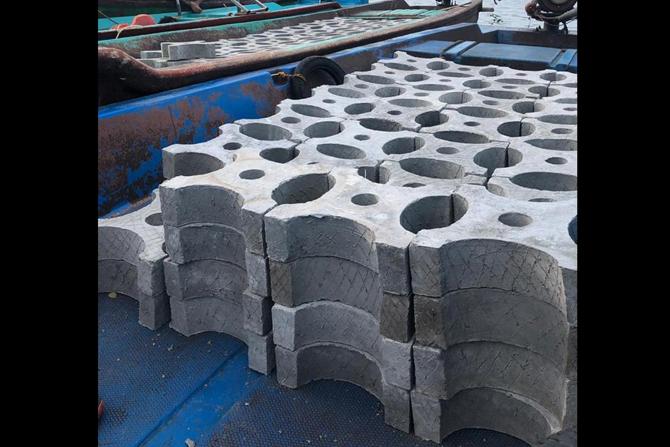Mumbai based student Siddharth Pillai has made an attempt to address the issue and what is interesting is the fact that he has created an artificial reef model that is to become home to many aquatic species off the Pondicherry coast

Siddharth Pillai
While the marine ecosystem is posing threat from various things at many places, a Mumbai based Siddharth Pillai a student of Mumbai’s BD Somani school is the first Indian to create a modular artificial reef in Pondicherry.
ADVERTISEMENT
Due to climate change, pollution and disruptive fishing practices, the marine ecosystem which is home to several important aquatic species which are important for maintaining a balance in the Environment are posing threat due to several factors.
Mumbai based student Siddharth Pillai has made an attempt to address the issue and what is interesting is the fact that he has created an artificial reef model that is to become home to many aquatic species off the Pondicherry coast.
It's being claimed that Siddharth is the first Indian to create a modular artificial reef in Pondicherry.
Siddharth has been actively diving since five years on the coasts of Andamans, Bali, and Malaysia and has a Masters certificate in Scuba Diving.
“When I was sixteen, while scuba diving in the Andamans, I learnt about coral bleaching, and the precariousness of the global situation regarding the overall marine ecosystem. Ever since then I have decided to work to the best of my ability to contribute towards rescuing these marine animals; I felt like I owed it to them.” Said Siddharth Pillai.
Siddharth explains the urge and the need behind the creation, “Natural reefs begin when small aquatic animals called polyps attach themselves to a rock on the seafloor and form a symbiotic relationship with bacteria. These organisms lend reefs their vibrant hues and help support millions of marine lives. When the ocean’s temperature rises beyond 31 degrees, coral bleaching occurs as polyps evict their bacteria resulting in the polyps losing both their colour and their prime source of nutrition. Once bleached, the coral dies in less than 30 days.”
It may be noted that Class 11 student Siddharth has spent the greater part of 2018 working with Temple Adventures, a dive centre at Pondicherry to create a model for an artificial coral reef structure.
“Pondicherry is blessed with a wonderful marine ecosystem, but over the last few decades, restless overfishing has destroyed its coral and killed its fish.” adds Siddharth.
While pursuing a 45-day 3-D printing workshop in Mumbai Sidharth had a eureka moment. His idea was to create a modular artificial reef design for sustainable and efficient coral growth, providing coral polyps a source of calcium, and giving fish a place to reside to escape the relentless fishing activities. On experimenting with various mixes the artificial reef blocks were created using a mix of dolomite (composed of calcium magnesium carbonate) and cement that coral polyps could latch on to thrive. These blocks were immersed on the seabed off Pondicherry in October 2018 and monitored over 6 months for successful growth of blastomeres and reef as well as a home for smaller fish species.
Siddharth’s 3D model has been granted patent by the Indian patent office and this pilot proved that the material (dolomite and cement) used to build the modular structures is beneficial for aquatic life and the modular artificial reef has positively impacted the marine eco-system.

“On successful competition of the pilot, using the same material, I designed a larger model – applying 3D design to create modular lego like blocks that could be attached to one another. The modular design doesn’t require heavy-duty machinery to deploy and can be used in remote locations to create artificial reefs at lower cost as well as extend the reef almost perennially. I got two hundred blocks made in Vasai, weighing 11 to 14 kgs each and transported them to Pondicherry by road. I received assistance from the Temple Dive Centre and a total of 10 people worked over 3 days through exceedingly reduced visibility, 20 metres deep in the Bay of Bengal to create a new reef and fish habitat,” said Siddharth whilst recalling the herculean task of installing the artificial reef on the seabed in Pondicherry coast.
He had raised around two lakhs through crowdfunding for the construction of the reef and has named it Bennington’s Reef as a tribute to the late American singer, songwriter, musician, and actor Chester Bennington. Siddharth is currently working with Temple Adventures to start a Reef Rebuilding program to offer all divers an opportunity to contribute towards conservation and developing Bennington’s Reef. Siddharth is also going to present a scientific paper on the same in the International congress of conservational Biology in Kuala Lampur in July 2019.
Catch up on all the latest Crime, National, International and Hatke news here. Also, download the new mid-day Android and iOS apps to get the latest updates
 Subscribe today by clicking the link and stay updated with the latest news!" Click here!
Subscribe today by clicking the link and stay updated with the latest news!" Click here!






